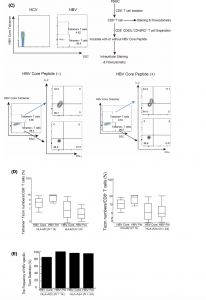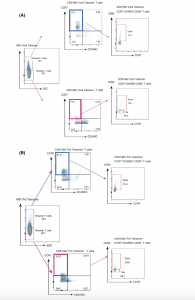Chronic hepatitis B infection poses a significant challenge, causing progressive liver damage with limited treatment options for eradication. Researchers are exploring a promising new strategy: harnessing the power of stem cell memory T cells (TSCMs) to combat the virus (Figure 1).

Figure 1: Detection of HBV-specific TSCMs from CD8-positive T cells in HLA-A24 or HLA-A02 HBV patients. (A) Gating strategy of HLA-A24-restricted HBV core-specific TSCMs. (B) Gating strategy of HLA-A24-restricted HBV Pol-specific TSCMs. (C) To confirm the specificity ofHBV Core/Pol tetramer, CD8 positive T cells were isolated from the peripheral blood of HCV-infected patients (N= 3) as negative controls,stained with PE-labeled HBV core/pol tetramer, and analyzed by flow cytometry. It also confirmed the characteristics of the tetramers weused by comparing the effects of HLA-A24-specific HBV Core epitope addition on IL-2 and IFN-c-producing cells in tetramer-positive andtetramer-negative cells. (D) Scatter graphs of the percentage of HBV Core- or Pol-specific Tetramer+TSCMs in CD8+T cells in HBV patientswith HLA-A02 (N= 14) (upper left) and HLA-A24 (N= 24) (upper right), and the percentage of TSCMs in CD8+T cells in HBV patients withHLA-A02 (N= 14) (lower left) and HLA-A24 (N= 24) (lower right). (E) Bar graphs of the detection rate of TSCM in HBV patients with HLA-A02 (N= 14) and HLA-A24 (N= 24).
The study identified TSCMs in patients with chronic HBV infection. These specialized immune cells hold the potential to differentiate into cytotoxic T cells, warriors capable of eliminating virus-infected liver cells. Researchers investigated this potential in a mouse model of HBV.
When TSCMs from patients were introduced into the mice, they successfully differentiated into cytotoxic T cells. These activated T cells mounted a powerful attack, eliminating HBV-infected liver cells. This finding suggests that enhancing patients’ own TSCMs could empower their immune system to overcome the chronic infection.
This hepatitis B model may provide valuable insights into the differentiation process of TSCMs into cytotoxic T cells. Additionally, it can help us understand the fate of these differentiated T cells within the body. This deeper knowledge can significantly propel future research on T cell-based therapies, offering hope for a more effective approach to chronic HBV infection.
Journal article: Abe-Chayama, H., et al, 2024. Hepatitis B virus-specific human stem cell memory T cells differentiate into cytotoxic T cells and eradicate HBV-infected hepatocytes in mice, FEBS Letters.
Summary by Stefan Botha











